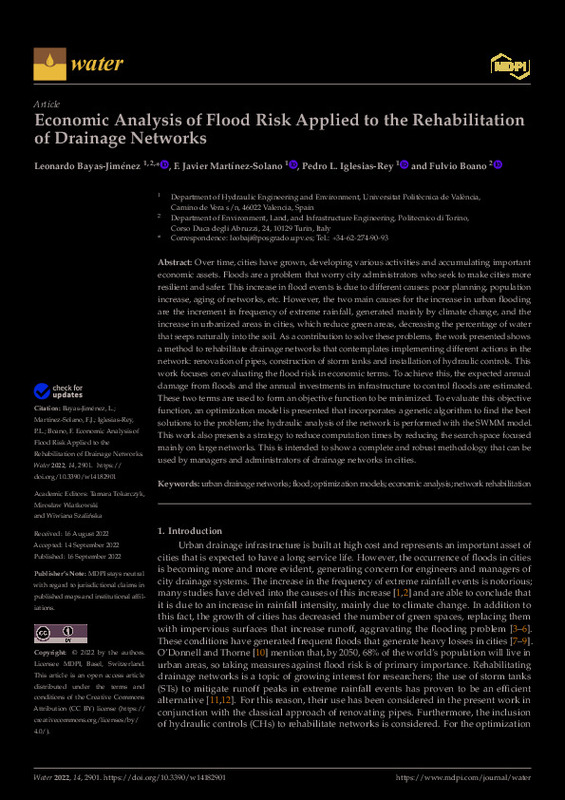JavaScript is disabled for your browser. Some features of this site may not work without it.
Buscar en RiuNet
Listar
Mi cuenta
Estadísticas
Ayuda RiuNet
Admin. UPV
Economic Analysis of Flood Risk Applied to the Rehabilitation of Drainage Networks
Mostrar el registro sencillo del ítem
Ficheros en el ítem
| dc.contributor.author | Bayas-Jiménez, Leonardo
|
es_ES |
| dc.contributor.author | Martínez-Solano, F. Javier
|
es_ES |
| dc.contributor.author | Iglesias Rey, Pedro Luís
|
es_ES |
| dc.contributor.author | Boano, Fulvio
|
es_ES |
| dc.date.accessioned | 2023-05-05T18:01:11Z | |
| dc.date.available | 2023-05-05T18:01:11Z | |
| dc.date.issued | 2022-09 | es_ES |
| dc.identifier.issn | 2073-4441 | es_ES |
| dc.identifier.uri | http://hdl.handle.net/10251/193160 | |
| dc.description.abstract | [EN] Over time, cities have grown developing various activities, and accumulating important eco-nomic assets. Floods are a problem that worries city administrators who seek to make them more resilient and safer. This increase in flood events is due to different causes, poor planning, population increase, aging of networks, etc. However, the two main causes for the increase in urban flooding are the increment in frequency of extreme rainfall generated mainly by climate change and the increase in urbanized areas in cities, which reduce green areas, decreasing the percentage of water that seeps naturally into the soil. As a contribution to solve these problems, the work presented shows a method to rehabilitate drainage networks that contemplates im-plementing different actions in the network: renovation of pipes, construction of storm tanks and installation of hydraulic controls. This work focuses on evaluating the flood risk in econom-ic terms. To achieve this, the expected annual damage from floods and the annual investments in infrastructure to control floods are estimated. These two terms are used to form an objective function to be minimized. To evaluate this objective function, an optimization model is present-ed that incorporates a genetic algorithm to find the best solutions to the problem; the hydraulic analysis of the network is performed with the SWMM model. This work also presents a strategy to reduce computation times by reducing the search space focused mainly on large networks. This is intended to show a complete and robust methodology that can be used by managers and administrators of drainage networks in cities. | es_ES |
| dc.description.sponsorship | The APC was funded by the Universitat Politecnica de Valencia. | es_ES |
| dc.language | Inglés | es_ES |
| dc.publisher | MDPI AG | es_ES |
| dc.relation.ispartof | Water | es_ES |
| dc.rights | Reconocimiento (by) | es_ES |
| dc.subject | Urban drainage networks | es_ES |
| dc.subject | Flood | es_ES |
| dc.subject | Optimization models | es_ES |
| dc.subject | Economic analysis | es_ES |
| dc.subject | Network rehabilitation | es_ES |
| dc.subject.classification | MECANICA DE FLUIDOS | es_ES |
| dc.title | Economic Analysis of Flood Risk Applied to the Rehabilitation of Drainage Networks | es_ES |
| dc.type | Artículo | es_ES |
| dc.identifier.doi | 10.3390/w14182901 | es_ES |
| dc.rights.accessRights | Abierto | es_ES |
| dc.contributor.affiliation | Universitat Politècnica de València. Escuela Técnica Superior de Ingenieros Industriales - Escola Tècnica Superior d'Enginyers Industrials | es_ES |
| dc.description.bibliographicCitation | Bayas-Jiménez, L.; Martínez-Solano, FJ.; Iglesias Rey, PL.; Boano, F. (2022). Economic Analysis of Flood Risk Applied to the Rehabilitation of Drainage Networks. Water. 14(18):1-20. https://doi.org/10.3390/w14182901 | es_ES |
| dc.description.accrualMethod | S | es_ES |
| dc.relation.publisherversion | https://doi.org/10.3390/w14182901 | es_ES |
| dc.description.upvformatpinicio | 1 | es_ES |
| dc.description.upvformatpfin | 20 | es_ES |
| dc.type.version | info:eu-repo/semantics/publishedVersion | es_ES |
| dc.description.volume | 14 | es_ES |
| dc.description.issue | 18 | es_ES |
| dc.relation.pasarela | S\485104 | es_ES |
| dc.contributor.funder | Universitat Politècnica de València | es_ES |
| dc.subject.ods | 06.- Garantizar la disponibilidad y la gestión sostenible del agua y el saneamiento para todos | es_ES |
| dc.subject.ods | 09.- Desarrollar infraestructuras resilientes, promover la industrialización inclusiva y sostenible, y fomentar la innovación | es_ES |
| dc.subject.ods | 11.- Conseguir que las ciudades y los asentamientos humanos sean inclusivos, seguros, resilientes y sostenibles | es_ES |








